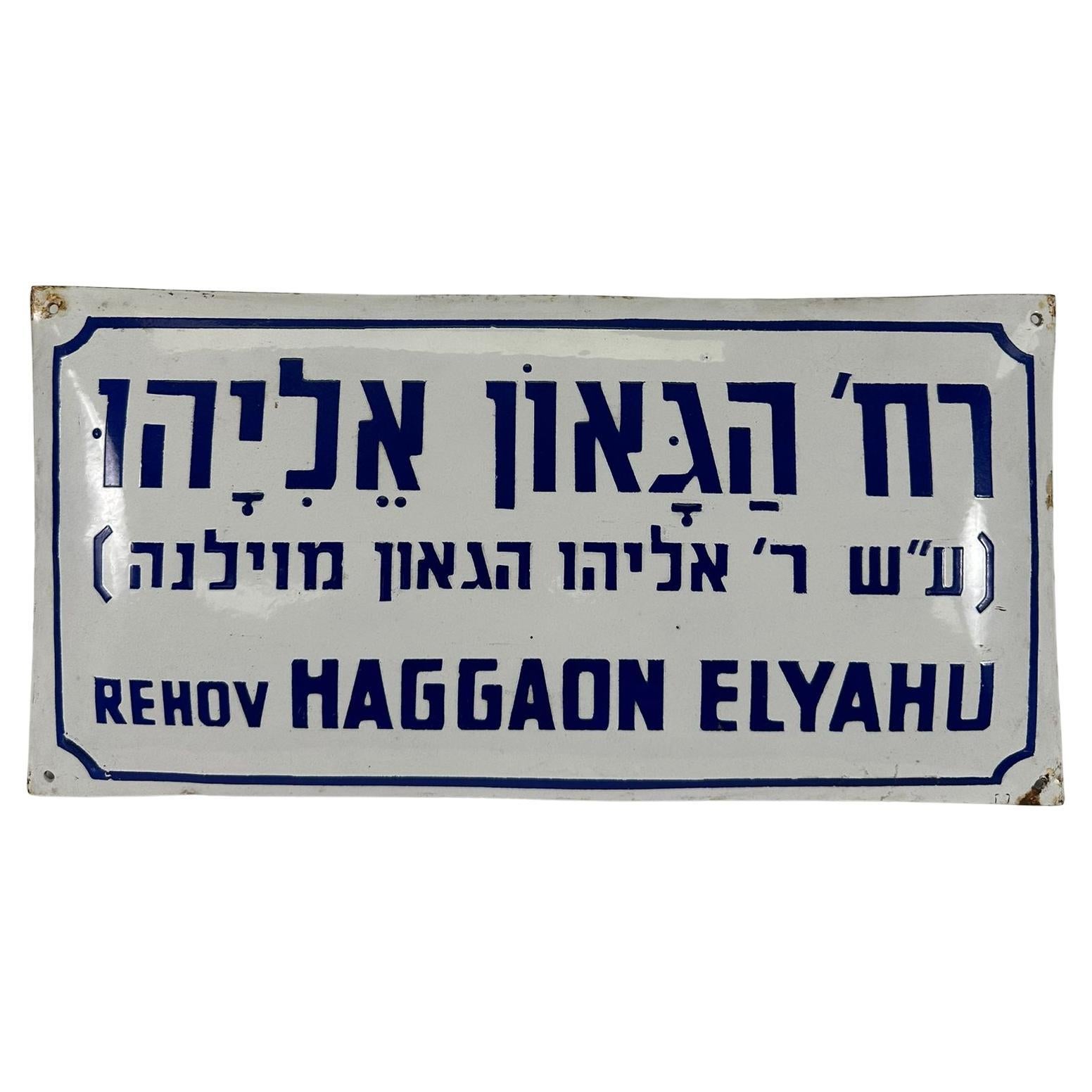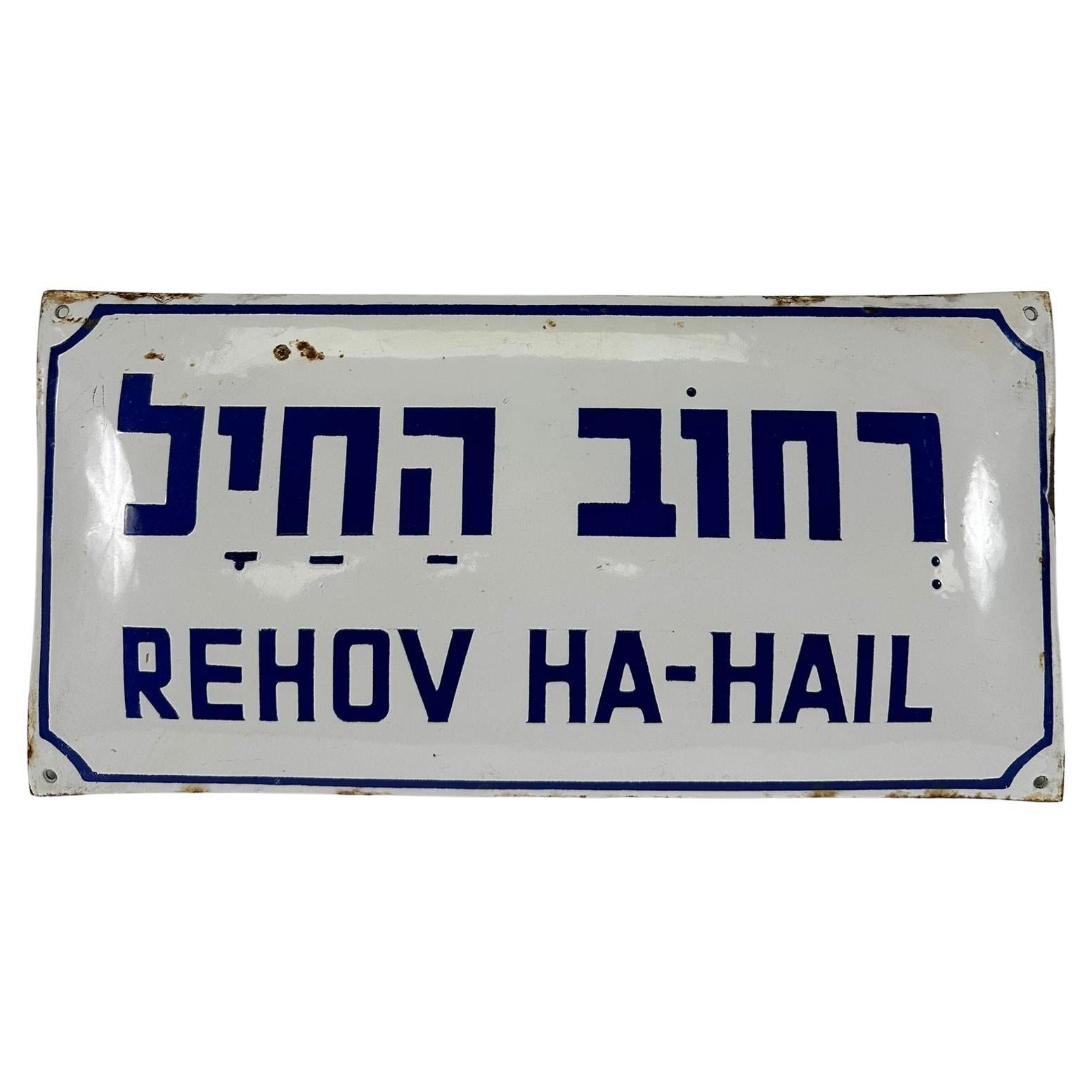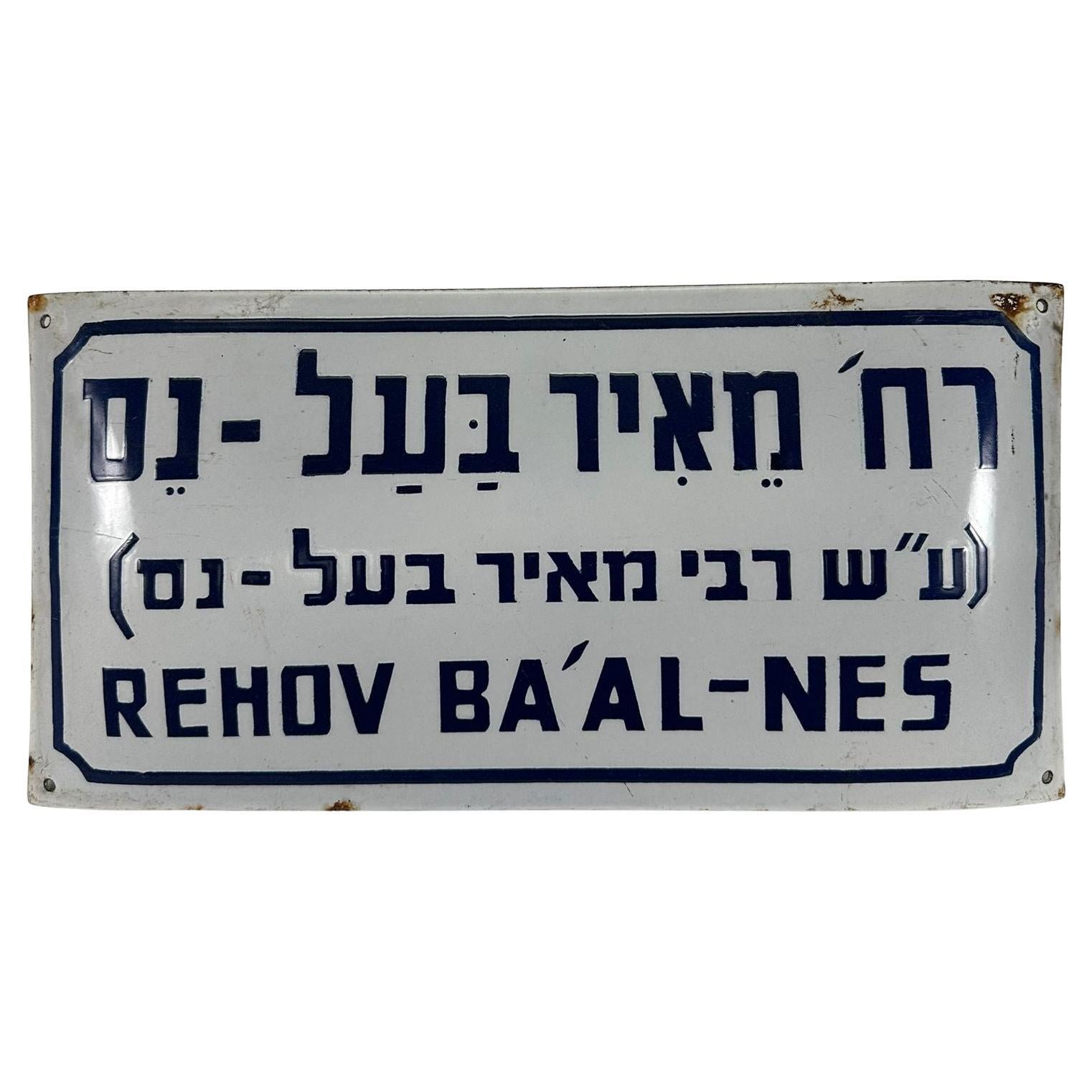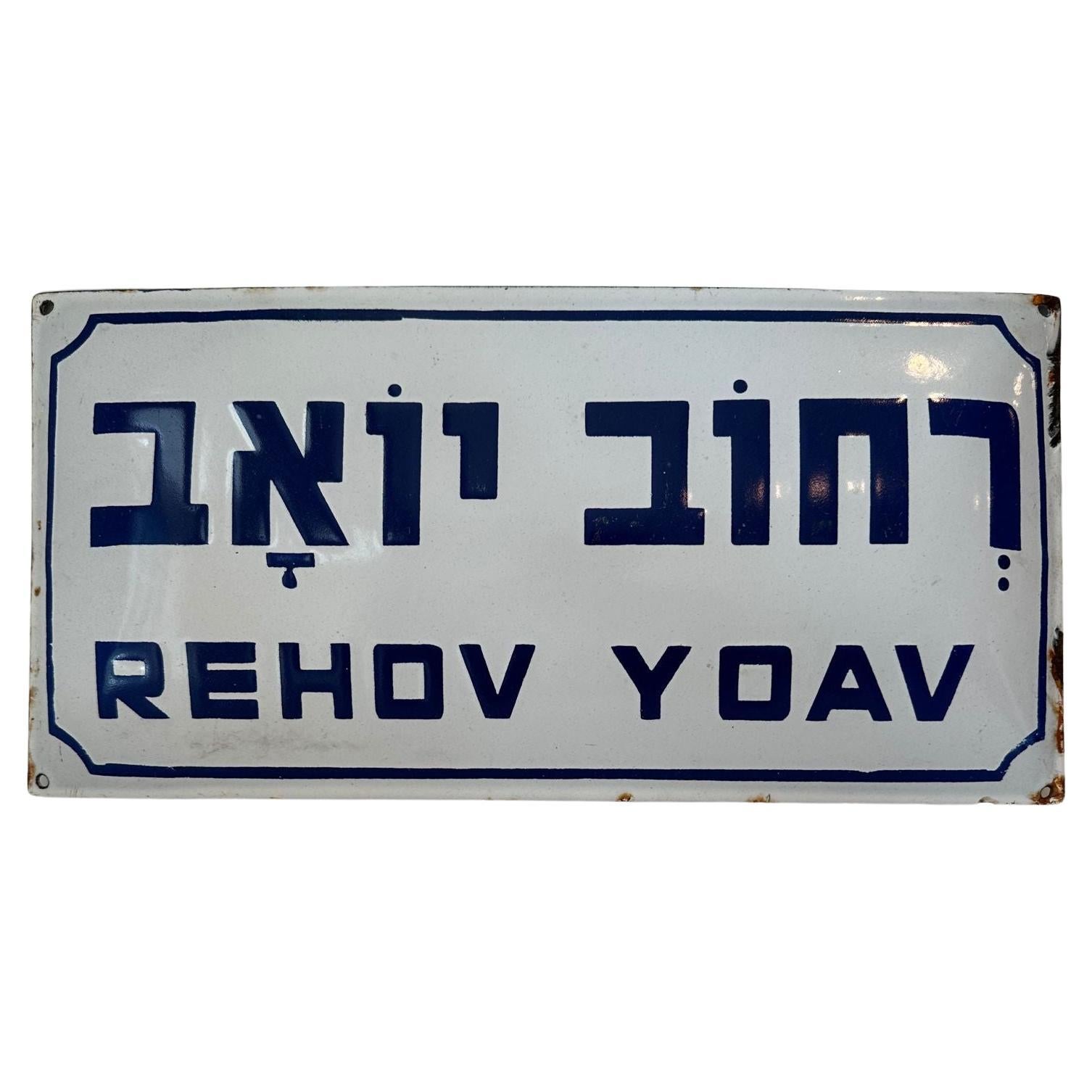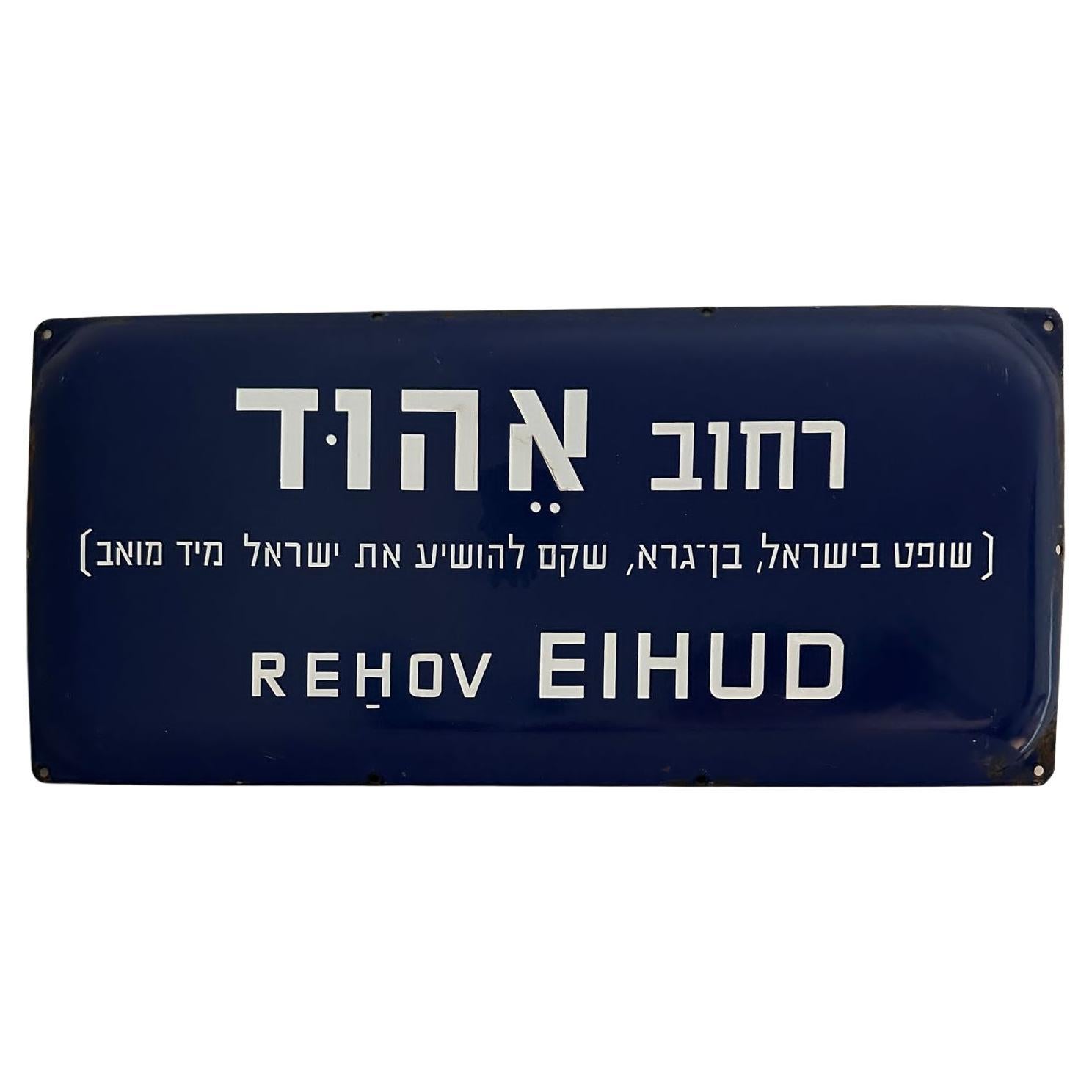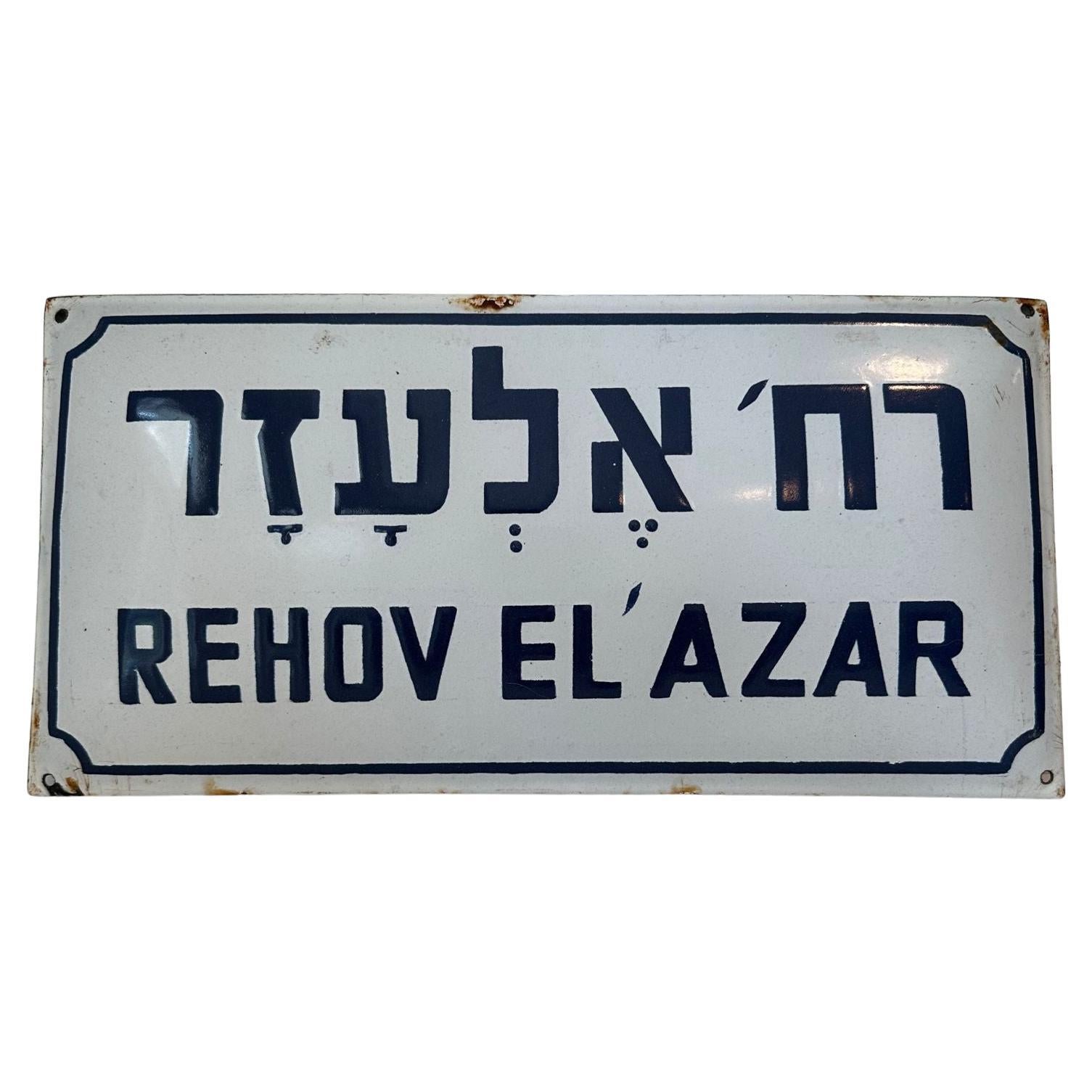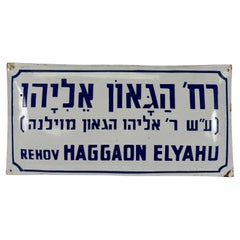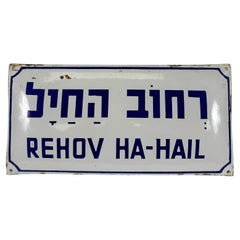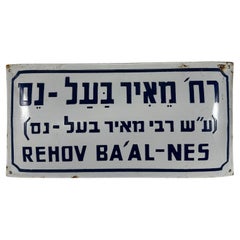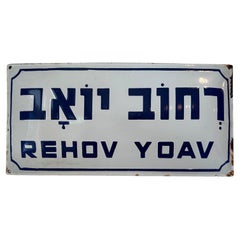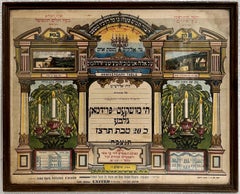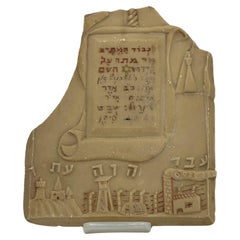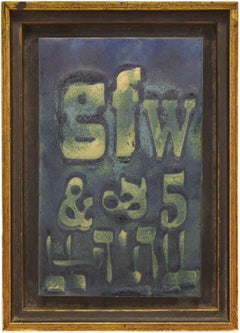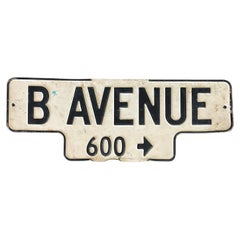Items Similar to Rehov Elisha – Israeli Enamel Street Sign (1948)
Want more images or videos?
Request additional images or videos from the seller
1 of 7
Rehov Elisha – Israeli Enamel Street Sign (1948)
$1,250
£948.47
€1,084.49
CA$1,745.91
A$1,941.22
CHF 1,013.60
MX$23,629.32
NOK 12,933.04
SEK 12,117.64
DKK 8,093.76
Shipping
Retrieving quote...The 1stDibs Promise:
Authenticity Guarantee,
Money-Back Guarantee,
24-Hour Cancellation
About the Item
This enamel-on-iron street sign, made in Israel in 1948, displays the name "Rehov Elisha" in both Hebrew and English. The Hebrew inscription, "רח' אלישע," translates to "Elisha Street." The design, with its simple blue lettering on a white background, is characteristic of early Israeli street signs, which were created during the rapid development of the newly established state. The sign shows minor rust and wear, indicating its age and historical significance. It represents both the practical need for urban infrastructure and the cultural tradition of naming streets after significant biblical figures.
Elisha, after whom this street is named, was a prophet in the Hebrew Bible and the spiritual successor of Elijah. He lived in the 9th century BCE and played a crucial role in the Kingdom of Israel. His story is mainly found in the Books of Kings, where he is described as a wonder-worker and a counselor to kings. Among his most well-known miracles is the parting of the Jordan River, an act that confirmed his inheritance of Elijah’s prophetic power. He is also remembered for multiplying a widow’s oil, ensuring her survival in times of hardship. His miraculous healing of Naaman, a Syrian commander afflicted with leprosy, stands out as a testament to his influence beyond the Israelite community. Another famous episode from his life includes the revival of the Shunammite woman’s son, a powerful demonstration of his divine authority.
Elisha’s legacy is deeply embedded in Jewish, Christian, and Islamic traditions. He is often regarded as a symbol of divine intervention, compassion, and unwavering faith. Streets named in his honor, like Rehov Elisha, reflect Israel’s connection to its biblical past and its enduring reverence for figures who shaped its spiritual and cultural history.
- Dimensions:Height: 7.88 in (20 cm)Width: 15.75 in (40 cm)Depth: 1.19 in (3 cm)
- Materials and Techniques:
- Place of Origin:
- Period:
- Date of Manufacture:1948
- Condition:Wear consistent with age and use.
- Seller Location:New York, NY
- Reference Number:1stDibs: LU5281243896642
About the Seller
5.0
Recognized Seller
These prestigious sellers are industry leaders and represent the highest echelon for item quality and design.
Established in 2006
1stDibs seller since 2020
130 sales on 1stDibs
Typical response time: 1 to 2 days
- ShippingRetrieving quote...Shipping from: New York, NY
- Return Policy
Authenticity Guarantee
In the unlikely event there’s an issue with an item’s authenticity, contact us within 1 year for a full refund. DetailsMoney-Back Guarantee
If your item is not as described, is damaged in transit, or does not arrive, contact us within 7 days for a full refund. Details24-Hour Cancellation
You have a 24-hour grace period in which to reconsider your purchase, with no questions asked.Vetted Professional Sellers
Our world-class sellers must adhere to strict standards for service and quality, maintaining the integrity of our listings.Price-Match Guarantee
If you find that a seller listed the same item for a lower price elsewhere, we’ll match it.Trusted Global Delivery
Our best-in-class carrier network provides specialized shipping options worldwide, including custom delivery.More From This Seller
View AllVintage Israeli Enamel Street Sign – "Rehov HaGaon Eliyahu" (1948)
Located in New York, NY
This enamel-on-iron street sign, produced in Israel in 1948, features Hebrew and English text in a classic blue-on-white design. It marks "Rehov HaGaon Eliyahu," a street named in ho...
Category
Mid-20th Century Israeli Historical Memorabilia
Materials
Enamel, Iron
Rehov Ha-Hail (Street of the Soldier) – Israeli Enamel Street Sign (1948)
Located in New York, NY
This enamel-on-iron street sign, produced in Israel in 1948, features bold Hebrew lettering spelling "רחוב החיל" (Rehov Ha-Hail), translated into English as "Street of the Soldier." ...
Category
Mid-20th Century Israeli Historical Memorabilia
Materials
Enamel, Iron
Israeli Enamel on Iron Street Sign: Rehov Ba'al-Nes (1948)
Located in New York, NY
This enamel-on-iron street sign, produced in Israel in 1948, bears the name "Rehov Ba'al-Nes" in Hebrew (רח' מאיר בעל-נס) and transliterated into Latin script as "Rehov Ba'al-Nes." T...
Category
Mid-20th Century Israeli Historical Memorabilia
Materials
Enamel, Iron
Mid-20th Century Enamel and Iron Israeli 'Yoav' Street Name Sign
Located in New York, NY
Mid-20th century handmade Israeli street name sign. Made of enamel and iron, this street sign was created shortly after the establishment of the state o...
Category
Vintage 1940s Israeli Mid-Century Modern Decorative Art
Materials
Enamel, Iron
$1,440 Sale Price
20% Off
Mid-20th Century Enamel and Iron Israeli 'Eihud' Street Name Sign
Located in New York, NY
Mid-20th century handmade Israeli street name sign. Made of enamel and iron, this street sign was created shortly after the establishment of the state of Israel in 1948. The sign is ...
Category
Vintage 1950s Israeli Mid-Century Modern Decorative Art
Materials
Enamel, Iron
$1,440 Sale Price
20% Off
Mid-20th Century Enamel and Iron Israeli 'El'azar' Street Name Sign
Located in New York, NY
Mid-20th century handmade Israeli street name sign. Made of enamel and iron, this street sign was created shortly after the establishment of the state of Israel in 1948. The sign is ...
Category
Vintage 1940s Israeli Mid-Century Modern Decorative Art
Materials
Enamel, Iron
$1,440 Sale Price
20% Off
You May Also Like
Rare Palestine Antique Hebrew Judaica Yahrzeit Synagogue Sign Memorial Plaque
Located in Surfside, FL
Circa 1890-1920. This Neoclassical, Judaic, Egyptian revival, Orientalist Mizrach sign, was produced in British Mandate Palestine by the chromolithograph process at the beginning of the 20th century. It pictures vignettes of holy places. with a hand written memorial. It was for the Tzedakah charity fund for the century-old institutions in Jerusalem: The great "Torah Center Etz Chaim"; a Free Kitchen for poor children and orphans; the famous Bikur Cholim Hospital with its dispensaries and clinics and the only Home for Incurable Invalids in Eretz Israel. They also worked with Arthur Szyk and Alfred Salzmann.. The A.L. Monsohn Lithographic Press (Monzon Press, Monson Press, דפוס אבן א"ל מאנזאהן, דפוס מונזון) was established in Jerusalem in 1892 by Abraham-Leib (or Avrom-Leyb) Monsohn II (Jerusalem, c.1871-1930) and his brother Moshe-Mordechai (Meyshe-Mordkhe). Sponsored by members of the Hamburger family, the brothers had been sent to Frankfurt, Germany in 1890 to study lithography. Upon returning to Jerusalem in 1892 with a hand press, they established the A.L. Monsohn Lithographic Press in the Old City of Jerusalem. According to the Information Center for Israeli Art A.L. Monsohn "created complex decorations for documents and oriental calendars that combined the tradition of Jewish art with modern printing techniques such as photographic lithography, raised printing and gilding."
The founders of the Monsohn press produced Jewish-themed color postcards, greeting cards, Jewish National Fund stamps, and maps documenting the evolution of the Jewish settlement in Eretz Israel in the nineteenth-twentieth centuries; religious material such as decorative plaques for synagogues, portraits of Old Yishuv rabbis such as Shmuel Salant, Mizrah posters indicating the direction of prayer for synagogues, memorial posters, and posters for Sukkot booths; color frontispieces for books such as Pentateuch volumes and the early song collections of Abraham Zvi Idelsohn (e.g., Shire Zion, Jerusalem 1908); artistic wedding invitations; and labels, packaging and advertisements for the pioneering entrepreneurs of Eretz Israel. The texts appearing in the Monsohn products were in several languages: Hebrew, Arabic, Yiddish, English, German (e.g., a c1920 trilingual Hebrew-English-Arabic "Malaria Danger" broadside warning the public of mosquitoes spreading malaria). Many of the brilliantly colored postcards and maps can be seen online as can the artistic invitations to his children's weddings which Monsohn published in the Jerusalem Hebrew press.
For years, the Monsohn (later, Monson/Monzon) Press was considered the best and most innovative in the country—pioneering in such techniques as gold-embossing and offset printing, among others. Early items for tourists included collections of Flowers of the Holy Land (c. 1910–1918)—pressed local flowers accompanied by scenes from the Eretz Israel countryside and relevant verses from the Bible, edited by Jsac Chagise (or Itzhak Haggis), an immigrant from Vitebsk, and bound in carved olive wood boards. Shortly after World War I Monsohn (now spelled מונזון) used zincography to produce the prints included in the Hebrew Gannenu educational booklets for young children illustrated by Ze'ev Raban of the Bezalel Academy of Art and Design and printed in Jerusalem by Hayim Refael Hakohen (vol. 1, 1919; vols. 2–3, 1920). In 1934 Monsohn moved into the new, western part of Jerusalem, in a shop with four presses and 30 workers, including Abraham-Leib's sons, David, Yosef, Moshe and Shimon, and his daughter Raytse's husband, Abraham Barmacz. The concern did business with all sectors of the city's population, including Arabs, for whom they printed in Arabic. Among their clients were members of the Ginio, Havilio, and Elite families, and Shemen, Dubek, and other renowned national brands, manufacturing products such as wine, candies, oil, and cigarettes. They also printed movie and travel posters, and government posters, postcards and documents, hotel luggage labels...
Category
Early 20th Century Aesthetic Movement More Art
Materials
Lithograph
Historic Rare Carved memorial plaque made by Jewish internee in Cyprus, 1948
Located in Tel Aviv - Jaffa, IL
super rare and historic example of Cyprus stone carving, made by jewish holocaust surviver that was Detained at the Internment camps in Cyprus, just 3 years after the holocaust. this piece is very unusual, most of this carvings shows us aspects of living in the Refugee camps or zionist views of israel, sometimes they even made judaica objects like menorahs Or Candlesticks, but its rare to find memorial plaques such as the example in front of us, the plaques was Damaged In the way to israel and two pieces from the upper section were broken off, the middle part of the Plaque shows a Scroll shaped memorial plaque with the inscription : "for the dead who died on the name of god" In red color, the middle has a yellow star carved and painted, just like the yellow star jewish...
Category
Vintage 1940s Cypriot Antiquities
Materials
Soapstone
Typeface, Hebrew Font and Numbers Enamel Judaica Art Plaque
By George F Welch
Located in Surfside, FL
Dimensions w/Frame: 10" x 7 1/2" x 1 1/2"
A George F. Welch Abstract Copper Enamel Wall Art Plaque Inscribed signature on the lower right of the plaqu...
Category
20th Century Modern Mixed Media
Materials
Enamel
Vintage Metal "B Avenue" Street Sign - City of Coronado, California
Located in San Diego, CA
Super cool vintage metal "B Avenue" street sign from the city of Coronado, California, circa 1970s. The piece is in good vintage condition with a distressed patina and measures: 24"W...
Category
Mid-20th Century American Mid-Century Modern Signs
Materials
Metal
1950s Belgian Transportation Sign
Located in High Point, NC
A vintage Belgian wooden sign made circa 1950. This retired transportation sign used to hang over a Brussels tram stop, printed neatly in French an...
Category
Vintage 1950s Belgian Historical Memorabilia
Materials
Metal
Antique Harvard Ave. Porcelain Sign c.1900-1910
Located in San Francisco, CA
ABOUT
An original double sided enameled porcelain Harvard Ave street sign.
Shown with life size hand model for scale.
CREATOR Unknown.
DATE OF MANUFACTURE c.1900-1900.
...
Category
Early 20th Century Industrial Signs
Materials
Enamel, Steel
